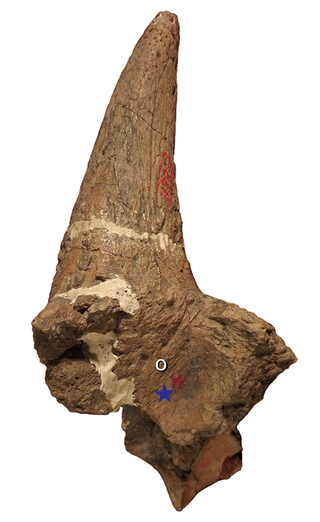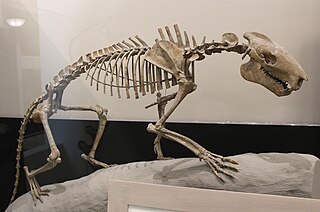
The Allegheny Plateau is a large dissected plateau area of the Appalachian Mountains in western and central New York, northern and western Pennsylvania, northern and western West Virginia, and eastern Ohio. It is divided into the unglaciated Allegheny Plateau and the glaciated Allegheny Plateau.

Entelodon, formerly called Elotherium, is an extinct genus of entelodont artiodactyl endemic to Eurasia. Fossils of species are found in Paleogene strata ranging in age from the Houldjinian until the Rupelian epoch of the early Oligocene.

Ceratops is a dubious genus of herbivorous ceratopsian dinosaur which lived during the Late Cretaceous. Its fossils have been found in the Judith River Formation in Montana. Although poorly known, Ceratops is important in the history of dinosaurs, since it is the type genus for which both the Ceratopsia and the Ceratopsidae have been named.

Laosaurus is a genus of neornithischian dinosaur. The type species, Laosaurus celer, was first described by O.C. Marsh in 1878 from remains from the Oxfordian-Tithonian-age Upper Jurassic Morrison Formation of Wyoming. The validity of this genus is doubtful because it is based on fragmentary fossils. A second species from the Morrison Formation, L. gracilis, and a species from the late Cretaceous Allison Formation of Alberta, Canada, Laosaurus minimus, are also considered dubious.

Nanosaurus is an extinct genus of neornithischian dinosaur that lived about 155 to 148 million years ago, during the Late Jurassic in North America. Its fossils are known from the Morrison Formation of the south-western United States. The type and only species, Nanosaurus agilis, was described and named by Othniel Charles Marsh in 1877. The taxon has a complicated taxonomic history, largely the work of Marsh and Peter M. Galton, involving the genera Laosaurus, Hallopus, Drinker, Othnielia, and Othnielosaurus, the latter three now being considered to be synonyms of Nanosaurus. It had historically been classified as a hypsilophodont or fabrosaur, types of generalized small bipedal herbivore, but more recent research has abandoned these groupings as paraphyletic and Nanosaurus is today considered a basal member of Neornithischia.

Dartmuthia is an extinct genus of primitive jawless fish that lived in the Silurian period. Fossils of Dartmuthia have been found in Himmiste Quarry, on the island of Saaremaa in Estonia. It was first described by William Patten.

Archaeotherium is an extinct genus of entelodont artiodactyl endemic to North America during the Eocene and Oligocene epochs. Archaeotherium fossils are most common in the White River Formation of the Great Plains, but they have also been found in the John Day Basin of Oregon and the Trans-Pecos area of Texas. Archaeotherium's fossils come from North America, between the Priabonian and Rupelian stages of the Eocene and Oligocene. Up to fifteen species of Archaeotherium have been identified, which are divided into three subgenera. One contains the type species, A. mortoni, among others; another contains very large taxa formerly named Megachoerus and Pelonax; and the last contains A. calkinsi.

John James Stevenson was an American geologist, born in New York City. He graduated from New York University in 1863, became professor of chemistry at West Virginia University for two years (1869–71), then served as professor of geology at New York University until 1909. During 1873–74 and from 1878 to 1880 he was geologist for the United States Geological Survey. He also served on the Pennsylvania Geological Survey from 1875 to 1878 and from 1881 to 1882. He was president of the Geological Society of America in 1898.
Dolerorthis is an extinct genus of hesperorthid brachiopod. The type species of this genus, D. interplicata, was described from the Silurian (Telychian) Osgood Formation. Other species belonging to this genus are known from the Ordovician and Silurian of Europe, Kazakhstan, China and Argentina. It was roughly 4 centimetres (1.6 in) across.

William Augustus Norton was a civil engineer and educator. He was the president of Delaware College and later a founding faculty member of the Sheffield Scientific School at Yale University.

Camarasaurus grandis is an extinct species of sauropod dinosaur in the genus that lived during the Jurassic in what is now the western United States. It is the geologically oldest of the four species of the genus Camarasaurus.
Theretairus is a Late Jurassic genus of sphenodont reptile from the Morrison Formation of western North America, present in stratigraphic zones 5 and 6.

Stegomosuchus is an extinct genus of small protosuchian crocodyliform. It is known from a single incomplete specimen discovered in the late 19th century in Lower Jurassic rocks of south-central Massachusetts, United States. It was originally thought to be a species of Stegomus, an aetosaur, but was eventually shown to be related to Protosuchus and thus closer to the ancestry of crocodilians. Stegomosuchus is also regarded as a candidate for the maker of at least some of the tracks named Batrachopus in the Connecticut River Valley.

Agriochoerus is an extinct genus of scansorial herbivore of the tylopod family Agriochoeridae, endemic to North America. Agriochoerus and other agriochoerids possessed claws, which is rare within Artiodactyla, as well as likely being scansorial. Agriochoerus was first described in 1869.
Indraloris is a fossil primate from the Miocene of India and Pakistan in the family Sivaladapidae. Two species are now recognized: I. himalayensis from Haritalyangar, India and I. kamlialensis from the Pothohar Plateau, Pakistan. Other material from the Potwar Plateau may represent an additional, unnamed species. Body mass estimates range from about 2 kg (4.4 lb) for the smaller I. kamlialensis to over 4 kg (8.8 lb) for the larger I. himalayensis.

The Ludlowville Formation is a geologic formation in New York, Ohio and Pennsylvania. It dates to the Devonian period.
Dhirendra Kishore Chakravarti was an Indian geologist and paleontologist, who worked at Banaras Hindu University in the Geological Museum.
Microsyops is a plesiadapiform primate found in Middle Eocene in North America. It is in the family Microsyopidae, a plesiadapiform family characterized by distinctive lanceolate lower first incisors. It appears to have had a more developed sense of smell than other early primates. It is believed to have eaten fruit, and its fossils show the oldest known dental cavities in a mammal.
Gavialis pachyrhynchus is an extinct species of gavialid from the Miocene of India. Although only known from fragmentary jaw material, the size of this material is substantially larger than comparable bones in large gharials.
Phrynops paranaensis is an extinct species of turtle in the family Chelidae. This fossil species is from the Huayquerian Ituzaingó Formation of the Paraná Basin, Argentina, likely to be late Miocene in origin.














